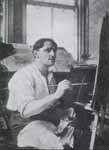(1879-1916)
~ Biography by Terence Cuneo ~
Cyrus Cuneo was a full blooded Italian, born in the United States and one of a large family including two brothers who became artists. He was also the father of the late Terence Cuneo, the distinguished British Artist whose career bore a startling resemblance to his own.
Even as a boy Cyrus, or ‘Ciro’ as he was always known, had one ambition – to get to Europe and study art in Paris. Ciro knew that fulfilment of this ambition must come entirely from his own efforts. He jealously guarded every cent he could gain.
Whilst still at school he took on a paper round, but his principle source of income was in staging shows and plays in the family stable, charging so many empty bottles for admission, which were later collected and sold.
As he grew into his teens he started boxing with his elder brother, Rinaldo, and other local enthusiasts. His undoubted prowess was soon apparent and small matches were arranged in and around San Francisco, nearly everyone of which he won. By the time he was nineteen he was flyweight champion of the city and with the purse he received, plus his savings, he turned his head to east.
Once he was in Paris he was just in time to enjoy the last of the romantic era. It was an untidy mixture of draughty garrets, picturesque creatures surrounded by the aroma of cabbage and living in a litter of dog-eared portfolios, ‘masterpiece’ canvases and mandolins. Not that this sort of existence was entirely fictitious. Such conditions certainly did exist for the students of the Carlo Rossi Academy, where Ciro studied for nearly four years. Before his second year was out Ciro had become Whistler’s massier or head student and had bolstered his income by giving boxing lessons. These not only paid the rent, but were also responsible for starting the vogue of boxing throughout the Latin Quarter.
In 1903 Ciro arrived in England and married Nell Tenison, daughter of Dr Ryan Tenison [a relative of the poet Tennyson]. She had spent the previous two years also as a student at the Carlo Rossi Academy. He immediately became inundated with work on magazines and book illustration. After this he went to Canada to carry out an important series of commissions for the Canadian Pacific Railway*. He then resumed his career in England. In 1910 when King Edward died, Ciro found himself working literally day and night in the office of the Illustrated London News, on spread after spread of the funeral and subsequent George V Coronation drawing. When the 1914 war broke out he moved smoothly onto war subjects, without being affected by the collapse of many of the peacetime periodicals. His war paintings were widely used and magnificent – one canvas, auctioned in 1915, raised enough to buy two ambulances which went to France, each bearing the inscription “The Cyrus Cuneo Ambulance”.
One summer’s morning a dove flew into the nursery and settled on the lintel under a fanlight. It stayed for most of the day, seeming composed and unafraid. The following afternoon it returned and the housemaid climbed on to a chair, lifted it down and gave it straight to Cyrus who had entered the room at that moment. A few days later, on an excursion to the basement a remark was made to the kitchen maid, “You mark my works Alice, it’s bad luck to ‘ave birds in the ‘ouse. It means death!”
It could not have been more than a day or two after this that Cyrus first showed the signs of blood poisoning – caused by the accidental stab of a hatpin at a dance he attended – which was to kill him. Within six weeks, on the 23rd July 1916, he was dead; thirty-seven years old and at the peak of a brilliant career.
*Regrettably much of this material was destroyed when CPR’s offices were burnt down during the Blitz of 1940.

